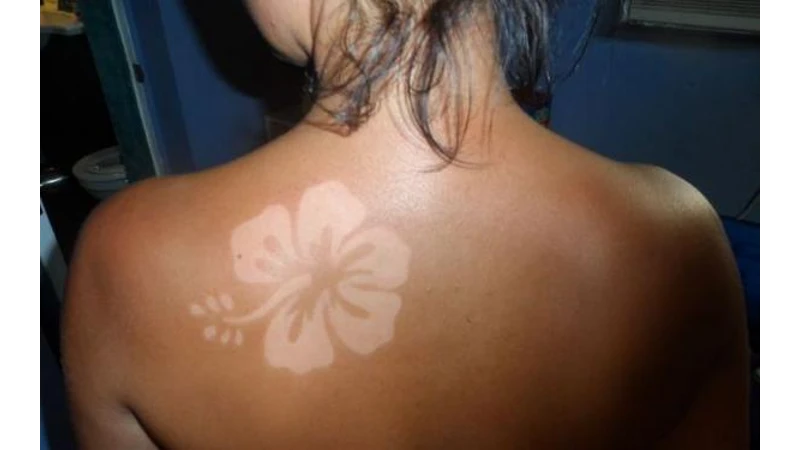What Are Sunburn Tattoos?
Sunburn tattoos, a trend that has gained popularity through social media, involve intentionally creating designs on the skin by selectively applying sunscreen or stencils before exposing the skin to sunlight. These “tattoos” form as the unprotected areas of the skin burn, leaving behind a contrasting pattern where sunscreen was applied.
While they may seem like a fun and artistic way to celebrate summer, the reality is far more dangerous than many people realize. Sunburn tattoos represent a serious health risk, particularly due to prolonged exposure to UV rays, which can cause irreversible damage to your skin.
The Health Risks of Sunburn Tattoos
1. Increased Risk of Skin Cancer
The most significant and concerning consequence of sunburn tattoos is the increased risk of skin cancer, particularly melanoma, the deadliest form of skin cancer. Research shows that experiencing just five or more severe sunburns in your lifetime doubles the risk of developing melanoma. By creating a sunburn tattoo, you are deliberately exposing large portions of your skin to UV radiation without protection, heightening the risk of developing both melanoma and other types of skin cancer such as squamous cell carcinoma and basal cell carcinoma.
2. Premature Skin Aging
Sun exposure without protection doesn’t just increase cancer risks; it also accelerates the aging process. Unprotected exposure to UV rays breaks down the collagen in the skin, leading to early signs of aging such as wrinkles, sagging, and loss of elasticity. People who engage in the sunburn tattoo trend are at greater risk of premature aging, with UV damage causing fine lines and age spots to appear earlier than they would under normal circumstances.
3. Sunburn and Immediate Physical Effects
Severe sunburn is no small matter. Sunburn tattoos often result in blistering, pain, swelling, and redness that make even the simplest tasks, such as wearing clothing or lying down, uncomfortable. In extreme cases, sunburn can lead to systemic symptoms such as fever, chills, nausea, and dehydration, potentially requiring medical attention.
4. Hyperpigmentation and Skin Discoloration
Unprotected UV exposure can cause hyperpigmentation, where certain areas of the skin darken excessively, leading to uneven skin tone and discoloration. This condition can be particularly persistent and difficult to treat, often requiring months of corrective skincare treatments to fade. Engaging in the sunburn tattoo trend, especially on highly visible areas such as the arms or legs, increases the risk of developing long-lasting pigmentation issues.
Why There’s No Safe Level of Sunburn
Health professionals emphasize that there is no “safe” level of sunburn. Even moderate sunburns are enough to cause DNA damage to skin cells, which can accumulate over time and lead to skin cancer. In fact, every instance of sunburn weakens the skin’s immune response, reducing its ability to fight off environmental damage.
Sunburn tattoos intentionally exceed any recommended sun exposure limits, putting participants at higher risk of long-term damage with just one burn session.
A Safer Alternative: Sunless Tanning
For those seeking a temporary design on their skin, a much safer alternative is to use sunless tanning products like spray tans or self-tanning lotions. These products, when applied using a stencil, can create the same tattoo effect without any of the harmful UV exposure. Not only do they protect your skin from burns, but they also allow you to achieve your desired look without compromising your health.
Benefits of Sunless Tanning:
- No UV radiation exposure
- Customizable designs that can be easily altered
- Safe for all skin types
- No risk of burns, blisters, or long-term skin damage
How to Protect Your Skin from UV Damage
1. Apply Broad-Spectrum Sunscreen Daily
Using a broad-spectrum sunscreen that protects against both UVA and UVB rays is essential to prevent skin damage. Choose a sunscreen with an SPF of 30 or higher, and make sure to reapply it every two hours or after swimming and sweating. Always cover all exposed areas of your skin, even on cloudy days.
2. Wear Protective Clothing and Accessories
Sun-protective clothing such as long-sleeved shirts, wide-brimmed hats, and UV-blocking sunglasses can greatly reduce your exposure to harmful UV rays. Look for clothing with a UPF (Ultraviolet Protection Factor) rating to ensure maximum protection.
3. Limit Sun Exposure During Peak Hours
The sun’s rays are strongest between 10 a.m. and 4 p.m. If possible, limit your time outside during these hours to reduce the risk of sunburn. When outdoors, seek shade whenever possible.
4. Stay Hydrated
Sun exposure can lead to dehydration, which exacerbates the effects of sunburn. Be sure to drink plenty of water, especially if you are spending time outdoors, to keep your body and skin hydrated.
Conclusion: Sunburn Tattoos Are Not Worth the Risk
While sunburn tattoos may look trendy and appealing, they come with a high cost to your skin’s health. The immediate pain of a sunburn is only the beginning—the long-term consequences include an increased risk of cancer, premature aging, and permanent skin damage. Instead of putting your health on the line for temporary designs, choose safer alternatives like sunless tanning or simply embrace your natural skin while protecting it from harmful UV rays.
Take care of your skin, and it will take care of you. The beauty of healthy skin will always outweigh the fleeting trend of a sunburn tattoo.
By protecting your skin from the sun’s harmful rays, you are investing in your long-term health. Choose safety over temporary fads, and let your skin stay youthful and radiant without the risk of irreversible damage.
All I can think when I see images of sunburn tattoos is: Ouch!
xxxxxxxxxxxxxxxxxxxxxxxxxxxxxxxxxxxxxxxxxxxxxxxxxxxxxxxxxxxxxxxxxxxxxxxxxx
The popularity of this trend has prompted the Skin Cancer Foundation to adopt an official position on sunburn art. Basically, don’t.
Encouraging sun damage for the sake of “art” results in more than just red skin. Serious sunburns can go beyond general discomfort resulting in skin that’s hot and sensitive to the touch. This can often lead to blistering, fainting, fever, chills and nausea that require medical attention. In fact, research has shown that experiencing five or more sunburns doubles a person’s risk for melanoma, the deadliest form of skin cancer. Additional consequences of unprotected sun exposure include premature signs of aging, wrinkles, skin discoloration and hyperpigmentation.
Although doctors, health professionals and scientists still cannot conclusively determine what is considered a “safe” amount of sun exposure, it’s a sure bet that getting a sunburn tattoo grossly exceeds any possible limit. A better idea? Applying a spray tan over a paper template.
While a sunburn tattoo may be temporary, the sun damage and increased risk of melanoma and skin cancer that accompany it definitely are not.




